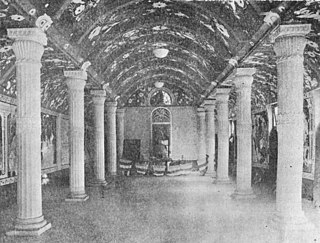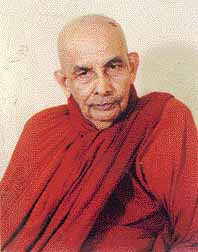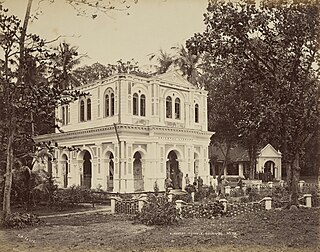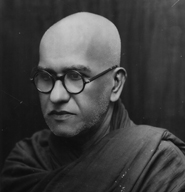Related Research Articles

Sir Edwin Arnold KCIE CSI was an English poet and journalist, who is most known for his work The Light of Asia.

Anagārika Dharmapāla was a Sri Lankan Buddhist revivalist and a writer.

Balangoda Ananda Maitreya Thero was a Sri Lankan Buddhist monk who was one of the most distinguished scholars and expositors of Theravada Buddhism in the twentieth century. He was highly respected by Sri Lankan Buddhists, who believed that he had achieved a higher level of spiritual development. Sri Lankan Buddhists also considered Balangoda Ananda Maitreya Thero as a Bodhisattva, who will attain Buddhahood in a future life.

The Maha Bodhi Society is a South Asian Buddhist society presently based in Kolkata, India. Founded by the Sri Lankan Buddhist leader Anagarika Dharmapala and the British journalist and poet Sir Edwin Arnold, its first office was in Bodh Gaya. The organization's efforts began in order to resuscitate Buddhism in India, and to restore the ancient Buddhist shrines at Bodh Gaya, Sarnath and Kushinara. The restoration and revival of the glory and sanctity of Bodh Gaya are also aims of Maha Bodhi Society.
Walpola Rahula Thero was a Sri Lankan Buddhist monk, scholar and writer. In 1964, he became the Professor of History and Religions at Northwestern University, thus becoming the first bhikkhu to hold a professorial chair in the Western world. He also once held the position of Vice-Chancellor at the then Vidyodaya University. He has written extensively about Buddhism in English, French and Sinhala. He wrote the book What the Buddha Taught about Theravada Buddhism.

Sri Sumangala College, in Panadura, Sri Lanka, was founded on 3 March 1909 at Rankoth Viharaya, in memory of Ven. Weligama Sri Sumangala Thero, who played an important role in Sri Lankan Buddhism. It is one of the oldest schools in the country. It is a national school, controlled by the central government as opposed to the Provincial Council. It is one of the largest Buddhist school in Sri Lanka, with a student population of 4,000 over 13 Grades.

Dharmaraja College, founded in 1887, is a boys' school in Kandy, Sri Lanka. It is a Buddhist school with around 300+ teaching staff and over 5,000 students. The school has many notable alumni including the first President of Sri Lanka William Gopallawa, A. E. Goonesinha, T.B Kehelgamuwa, Chamara Kapugedera, Sudarshana Pathirana and others.

Patrick de Silva Kularatne was a Sri Lankan educationist and politician. He was a Member of the State Council of Ceylon (1942-1947) and Member of Parliament (1960-1965). He served as Principal of Ananda College and Dharmaraja College and established Nalanda College Colombo, Ananda Balika Vidyalaya, Moratuwa Vidyalaya and Dharmapala Vidyalaya. As a member of the executive committee on Education, he played an instrumental role in the realisation of free education from kindergarten to university.

Panadura is a city in Kalutara District, Western Province in Sri Lanka. It is located approximately 27 km (17 mi) south of Colombo and is surrounded on all sides by water; the Indian Ocean, the Bolgoda Lake and river. Panadura is famed as the location of important events in the Buddhist revival movement of Sri Lanka.

Charles Henry de Soysa Dharmagunawardana Vipula Jayasuriya Karunaratna Disanayaka popularly known as Charles Henry de Soysa, JP was a Ceylonese entrepreneur and philanthropist. He was a pioneering planter, industrialist and was the wealthiest Ceylonese of the 19th century. He was instrumental in the establishment of the first Ceylonese bank, the Moratuwa carpenters guild, the Ceylon Agricultural and National Associations. He is widely regarded as the greatest philanthropist of the island for contributions which includes the De Soysa Maternity Hospital, the Prince and Princess of Wales Colleges, the Model Farm Experimental Station and many other institutions and acts of charity, establishing infant-maternal healthcare and secular education for girls in the country. He would have been the island's first Knight Bachelor, but having died prior, his widow was given the rare honor of the use of the style and dignity of wife of the Knight Bachelor and was known as Catherine, Lady de Soysa.

Gunapala Piyasena Malalasekera, OBE, JP, was a Sri Lankan academic, scholar and diplomat best known for his Malalasekara English-Sinhala Dictionary. He was Ceylon's first Ambassador to the Soviet Union, Ceylon's High Commissioner to Canada, the United Kingdom and Ceylon's Permanent Representative to the United Nations in New York. He was the Professor Emeritus in Pali and Dean of the Faculty of Oriental Studies.

Sir Susantha de Fonseka KBE was a Ceylonese statesman and diplomat. He was the Deputy Speaker of the State Council of Ceylon and following Ceylon's independence from Britain his first Ambassador to Burma and first Ambassador to Japan. De Fonseka took an active part in the country's struggle for universal suffrage and self-determination.

Ven. Migettuwatte Gunananda Thera or Mohottiwatte Gunananda Thera was a Sri Lankan Sinhala Buddhist orator. He is known for leading the Buddhist side in debates between Buddhists and Christians in Baddegama, Udanwita, Waragoda, Liyanagemulla, Gampola, and Panadura, where the most famous of the debates took place. As a result of the debates, Buddhism in Sri Lanka saw a revival.

Most Venerable Madihe Pannaseeha Mahathera was an eminent Sri Lankan Buddhist monk, who was the Mahanayaka of Amarapura sect from July 13, 1969, until his death on September 9, 2003.

Wariyapola Sri Sumangala was a Buddhist monk who lived in the early 19th century in Sri Lanka. He was an Anunayaka of the Asgiriya Chapter. Sri Sumangala is known for taking down the Union Jack and re-hoisting the Sinhalese lion flag, before the convention that handed over control of the island to the British in 1815. Later during the rebellion of 1818, he removed the Tooth Relic of the Buddha from the Temple of the Tooth, and handed it over to the leaders of the rebellion. He was arrested and convicted for treason the same year.

The Vidyodaya Pirivena was one of the prominent piriven in Sri Lanka. It was founded in 1873 by Ven. Hikkaduwe Sri Sumangala Thera and later in 1959, the pirivena was granted the university status by the Government of Sri Lanka.

Sir Bennet Soysa, CBE was a Ceylonese politician and philanthropist. He was a member of the 2nd State Council of Ceylon and the Senate of Ceylon. He was also Mayor of Kandy on five occasions and dedicated his wealth for the propagation of Buddhism.

Hikkaduwe Sri Sumangala Thera was a Sri Lankan Buddhist monk, who was one of the pioneers of Sri Lankan Buddhist revivalist movement in the 19th century. He did a great service to improve the Buddhist Education in the country and was the founder of Vidyodaya Pirivena, Maligakanda in 1873, which was granted the university status later in 1959 by the Government of Sri Lanka. A veteran author and a fiery orator, he was a major figure in the Panadurawadaya, a religious debate held between Christian missionaries and Buddhist monks in 1873 at Panadura, Sri Lanka. He was well versed in Sinhala, Pali, Sanskrit, English, Buddhism, history, arithmetic, and archaeology and was one of the primary sources of information on Buddhism for the success of the Panadura debate.

Palane Vajiragnana Thero was a Sri Lankan (Sinhala) scholar Buddhist monk, who founded the Siri Vajiraramaya temple in Bambalapitiya, Sri Lanka. He was also the Maha Nayaka (head) of Amarapura Sri Dharmarakshita sect for 37 years from August 5, 1918 until his death in 1955.

Sri Piyaratana Tissa Mahanayake Thero, also known as Dodanduwa Piyaratne Thero, was the Mahanayaka Thero of the Amarapura Nikaya, and the Sanganayake of the Southern Province. He popularised the 'Poruwa' ceremony at Buddhist weddings.
References
- 1 2 3 4 5 6 7 "Weligama Sri Sumangala Thero".
- ↑ Oxford University (1879). Trübner's American and oriental literary record. Oxford University. p. 120.
- ↑ Harvey 303
- ↑ India Revisited by Sri Edwin Arnold
- ↑ Dipak K. Barua, “Buddha Gaya Temple: its history”
- ↑ Sir Edwin Arnold (1892). The light of Asia, or, The great renunciation. Pennsylvania State University. p. 120.
- ↑ "Sri Sumangala College, Panadura".
- ↑ "Sri Sumangala Girls College, Panadura".